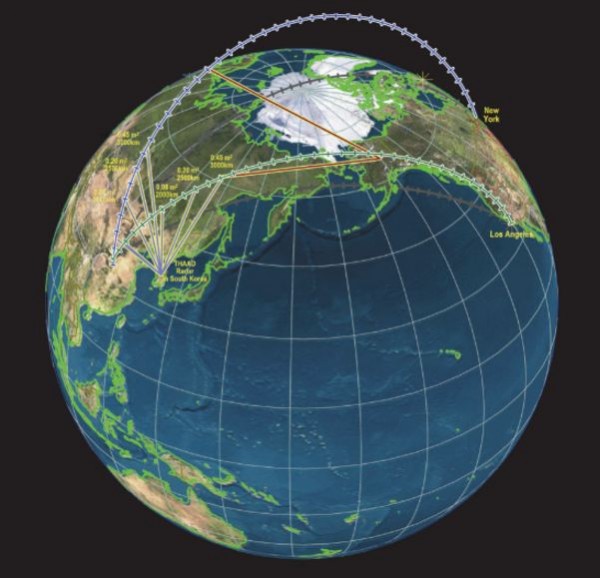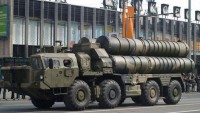China, Russia Consider Joint Missile Warning System to Counter US THAAD
| Arthur Dominic Villasanta | | Aug 27, 2016 10:33 AM EDT |
(Photo : George Lewis/Theodore Postol) THAAD AN/TPY-2 coverage range for a radar in South Korea tracking a missile launch in China.
China and Russia will likely establish a joint missile warning system to neutralize what they see as national security threats stemming from the radar coverage of the United States' Terminal High Altitude Area Defense (THAAD) missile system to be deployed to South Korea in 2017.
The joint U.S. South Korea decision to go ahead with THAAD's deployment to two military bases in South Korea is being seen by some Moscow analysts as the catalyst bringing about a rapprochement between Moscow and Beijing, particularly in missile defense.
Like Us on Facebook
Russia has take strong exception to Washington's decision to deploy THAAD and brushed aside the U.S. claim the aim of deploying this anti-missile missile system is to counter North Korea's continued development of ballistic missiles and weapons of mass destruction.
Russia argues the detection abilities of THAAD's radar will allow the U.S. to spy on Russian and Chinese ballistic and aerodynamic targets up to 1,500 kilometers away. From South Korea, the Americans can peer into the Russian territory and China's, as well, said the Russians.
An appropriate response to THAAD "could be the creation of a unified system of Russia and China, a sort of missile defense system," said military expert and Deputy Director of Institute of CIS countries, Vladimir Yevseyev.
China, North Korea's main ally and benefactor, claimed THAAD would destabilize the regional security balance without achieving anything to end North Korea's nuclear program.
"The Chinese side will consider taking necessary steps to maintain national strategic security and regional strategic balance," warned China's Ministry of National Defense in last June.
And earlier this August, the People's Daily (the official newspaper of the Communist Party of China) harshly criticized the U.S .move, warning that China and Russia would be forced to take "unexpected" but justified "countermeasures that the US and South Korea cannot afford."
That warning has apparently led to today's decision by Russia and China to seriously consider building a joint missile defense system to counter THAAD's electronic espionage.
The radar used by a THAAD battery is the X-band AN/TPY-2. This has two configurations: a Terminal Mode with a range of 600 km and a Forward-Based Mode whose exact range remains secret but might be anywhere from 1,500 km to 3,000 km, according to experts
Yevseyev, however, revealed the Russians and Chinese have jointly held anti-missile drills using computer modeling even before the decision to deploy THAAD to South Korea was announced. He said the next step for Russia and China after the formal decision to set up a joint defense system will be to acquire hands-on experience of intercepting ballistic targets in joint exercises.
This experience might be derived at the Russia's Ashuluk surface-to-air missile station in the Astrakhan Region. Ashuluk is a training facility for anti-aircraft missile and radiotechnical troops.
Tagschina, Russia, joint missile warning system, Terminal High Altitude Area Defense, THAAD, South Korea, AN/TPY-2
©2015 Chinatopix All rights reserved. Do not reproduce without permission
EDITOR'S PICKS
-

Did the Trump administration just announce plans for a trade war with ‘hostile’ China and Russia?
-

US Senate passes Taiwan travel bill slammed by China
-

As Yan Sihong’s family grieves, here are other Chinese students who went missing abroad. Some have never been found
-

Beijing blasts Western critics who ‘smear China’ with the term sharp power
-

China Envoy Seeks to Defuse Tensions With U.S. as a Trade War Brews
-

Singapore's Deputy PM Provides Bitcoin Vote of Confidence Amid China's Blanket Bans
-

China warns investors over risks in overseas virtual currency trading
-

Chinese government most trustworthy: survey
-

Kashima Antlers On Course For Back-To-Back Titles
MOST POPULAR
LATEST NEWS
Zhou Yongkang: China's Former Security Chief Sentenced to Life in Prison

China's former Chief of the Ministry of Public Security, Zhou Yongkang, has been given a life sentence after he was found guilty of abusing his office, bribery and deliberately ... Full Article
TRENDING STORY

China Pork Prices Expected to Stabilize As The Supplies Recover

Elephone P9000 Smartphone is now on Sale on Amazon India

There's a Big Chance Cliffhangers Won't Still Be Resolved When Grey's Anatomy Season 13 Returns

Supreme Court Ruled on Samsung vs Apple Dispute for Patent Infringement

Microsoft Surface Pro 5 Rumors and Release Date: What is the Latest?













